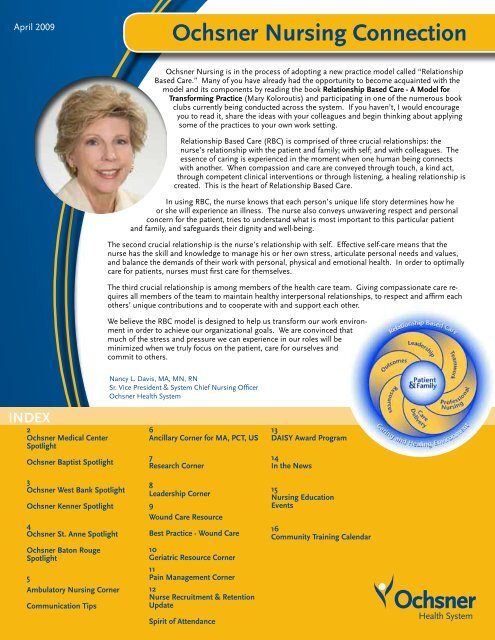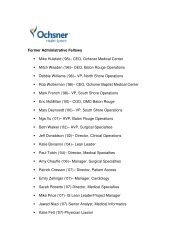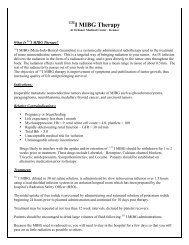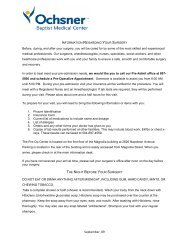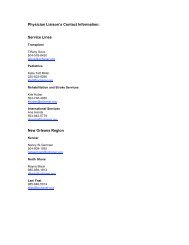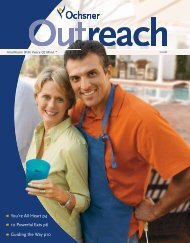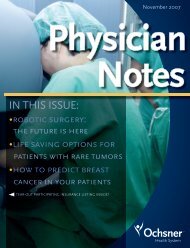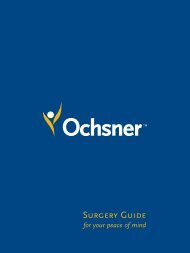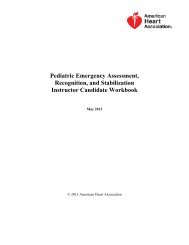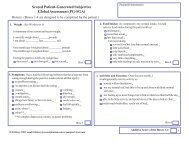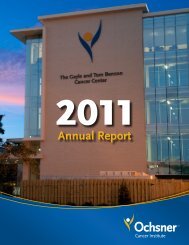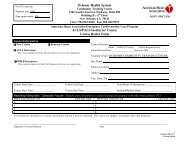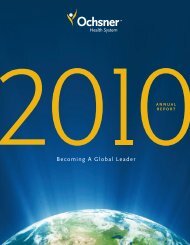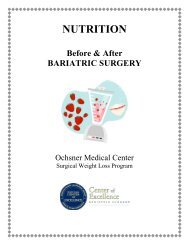Ochsner Nursing Connection - Ochsner.org
Ochsner Nursing Connection - Ochsner.org
Ochsner Nursing Connection - Ochsner.org
You also want an ePaper? Increase the reach of your titles
YUMPU automatically turns print PDFs into web optimized ePapers that Google loves.
April 2009<br />
<strong>Ochsner</strong> <strong>Nursing</strong> <strong>Connection</strong><br />
<strong>Ochsner</strong> <strong>Nursing</strong> is in the process of adopting a new practice model called “Relationship<br />
Based Care.” Many of you have already had the opportunity to become acquainted with the<br />
model and its components by reading the book Relationship Based Care - A Model for<br />
Transforming Practice (Mary Koloroutis) and participating in one of the numerous book<br />
clubs currently being conducted across the system. If you haven’t, I would encourage<br />
you to read it, share the ideas with your colleagues and begin thinking about applying<br />
some of the practices to your own work setting.<br />
Relationship Based Care (RBC) is comprised of three crucial relationships: the<br />
nurse’s relationship with the patient and family; with self; and with colleagues. The<br />
essence of caring is experienced in the moment when one human being connects<br />
with another. When compassion and care are conveyed through touch, a kind act,<br />
through competent clinical interventions or through listening, a healing relationship is<br />
created. This is the heart of Relationship Based Care.<br />
In using RBC, the nurse knows that each person’s unique life story determines how he<br />
or she will experience an illness. The nurse also conveys unwavering respect and personal<br />
concern for the patient, tries to understand what is most important to this particular patient<br />
and family, and safeguards their dignity and well-being.<br />
The second crucial relationship is the nurse’s relationship with self. Effective self-care means that the<br />
nurse has the skill and knowledge to manage his or her own stress, articulate personal needs and values,<br />
and balance the demands of their work with personal, physical and emotional health. In order to optimally<br />
care for patients, nurses must first care for themselves.<br />
The third crucial relationship is among members of the health care team. Giving compassionate care requires<br />
all members of the team to maintain healthy interpersonal relationships, to respect and affirm each<br />
others’ unique contributions and to cooperate with and support each other.<br />
We believe the RBC model is designed to help us transform our work environment<br />
in order to achieve our <strong>org</strong>anizational goals. We are convinced that<br />
much of the stress and pressure we can experience in our roles will be<br />
minimized when we truly focus on the patient, care for ourselves and<br />
commit to others.<br />
Nancy L. Davis, MA, MN, RN<br />
Sr. Vice President & System Chief <strong>Nursing</strong> Officer<br />
<strong>Ochsner</strong> Health System<br />
INDEX<br />
2<br />
<strong>Ochsner</strong> Medical Center<br />
Spotlight<br />
<strong>Ochsner</strong> Baptist Spotlight<br />
6<br />
Ancillary Corner for MA, PCT, US<br />
7<br />
Research Corner<br />
13<br />
DAISY Award Program<br />
14<br />
In the News<br />
3<br />
<strong>Ochsner</strong> West Bank Spotlight<br />
<strong>Ochsner</strong> Kenner Spotlight<br />
4<br />
<strong>Ochsner</strong> St. Anne Spotlight<br />
<strong>Ochsner</strong> Baton Rouge<br />
Spotlight<br />
5<br />
Ambulatory <strong>Nursing</strong> Corner<br />
Communication Tips<br />
8<br />
Leadership Corner<br />
9<br />
Wound Care Resource<br />
Best Practice - Wound Care<br />
10<br />
Geriatric Resource Corner<br />
11<br />
Pain Management Corner<br />
12<br />
Nurse Recruitment & Retention<br />
Update<br />
Spirit of Attendance<br />
15<br />
<strong>Nursing</strong> Education<br />
Events<br />
16<br />
Community Training Calendar<br />
Health System<br />
TM
Spotlight<br />
OCHSNER MEDICAL CENTER – NEW ORLEANS<br />
Greetings to all at OMC.<br />
The first few months of a new year are always full of exciting<br />
changes and transitions as we refocus our energy on the goals<br />
and priorities of that year; thus far, 2009 has been no exception.<br />
Although we continue to anticipate great things over the<br />
coming months, I would like to take a moment to reflect on a<br />
few of OMC’s outstanding accomplishments in 2008.<br />
On May 13, 2008, we received news of our Magnet re-designation.<br />
The appraisers had fabulous things to say about our nursing<br />
teams and cited 40 exemplars. We could not be more proud<br />
of this prestigious accomplishment.<br />
Last year marked tremendous growth for our nursing family.<br />
Our centralized Nurse Recruitment Department hired 414<br />
nurses that you helped train and precept. Once again, we welcome<br />
our newest nurses and recognize the contributions that<br />
you have already made to <strong>Ochsner</strong> nursing excellence.<br />
We initiated best practices in 2008 for both the inpatient and<br />
ambulatory settings and participated in a record number of<br />
scholarly works. Our commitment to process improvement,<br />
professional development and education help to set us apart<br />
from other local and national healthcare facilities. These accomplishments<br />
and others have created a strong foundation to<br />
bring us to new heights in 2009.<br />
In order to continue to be successful, we must remain focused<br />
on our goals of high patient satisfaction, high employee<br />
morale, clinical excellence, and financial stability. We set our<br />
targets high, so it will not be easy, especially with all the various<br />
daily and external challenges. With your input and all of us<br />
working together, I am optimistic that we can reach these goals.<br />
So again, to those of you who are new, welcome aboard and for<br />
those of you who have gotten us to where we are, thank you for<br />
all that you do.<br />
Nattie Leger, MSN, RN<br />
Vice President, <strong>Nursing</strong> & Operations<br />
OCHSNER BAPTIST MEDICAL CENTER<br />
Baptist is Back!! That is the statement our President of the Medical Staff proudly announced at our grand opening of the Emergency<br />
Department and Clara Wing expansion on January 12, 2009. We began our facility under <strong>Ochsner</strong> ownership on October<br />
1, 2007 and our progress has not stopped since then. We opened with a ten bed inpatient unit on that day and as of January,<br />
2009 we have 26 inpatient beds, a 12 bed ICU, and a 14 bed Emergency Department. By the end of February, we have a total of<br />
52 inpatient beds. Our management team, as well as staff, has not stopped.<br />
The <strong>Nursing</strong> department restructured leadership by promoting Operations Coordinators and Clinical Coordinators. We are very<br />
proud of our new leaders. Look for a list of their names in the next issue.<br />
With our expansion, our leadership team will assist in making our facility stronger. Our goal this year focuses on Quality and<br />
Patient Satisfaction. With our growth, it is important for us to maintain satisfaction, and our quality metrics will be impacted<br />
with the addition of our Emergency Department and the addition of a large number of new staff.<br />
With each newsletter, we will keep all abreast of all that is happening at <strong>Ochsner</strong> Baptist and we welcome anyone to come visit!<br />
Donna Martin, RNC<br />
Chief <strong>Nursing</strong> Officer<br />
2
OCHSNER MEDICAL CENTER – WEST BANK<br />
It is with great pleasure that I write the first CNO address for<br />
<strong>Ochsner</strong> West Bank. Below are some of our accomplishments<br />
in 2008:<br />
• Elimination of contract agency<br />
• <strong>Nursing</strong> turnover 11.5%<br />
• Two Press Ganey Compass Awards: Emergency Department<br />
and Inpatient areas. The Compass Award is a National<br />
award for the most improvement in patient satisfaction<br />
scores within one year.<br />
• <strong>Nursing</strong> satisfaction scores above national benchmark<br />
by the National Database of <strong>Nursing</strong> Quality Indicators<br />
(NDNQI) survey<br />
• Improved employee morale<br />
• Improved quality metrics<br />
• Improved community image and involvement with the<br />
community<br />
• Dramatically improved Emergency Department operations:<br />
LWBS
Spotlight<br />
OCHSNER ST. ANNE GENERAL HOSPITAL<br />
Greetings from the Bayou!! Isn’t it hard to believe that we are already into the second quarter of 2009? Time just goes so quickly,<br />
so we must make good use of the time we have. This year promises to be an exciting and informative year for us. We are entering<br />
our third year as part of a major health system. We are learning and sharing much and it is working out to be a win-win for us all.<br />
Our patient satisfaction scores took a dip in the fourth quarter so we have to get them right back up to that 90%. We are starting<br />
hourly rounding, which is a proven “Best Practice” to improve patient satisfaction. This rounding is “rounding with a purpose.”<br />
It is about speaking with the patient to identify their needs and letting patients know that we do have time for them. According to<br />
the literature, hourly rounding also decreases patient falls and decubitus ulcers. It is proven to be cost effective in that it decreases<br />
the time spent by nurses and nurse assistants answering call lights. Imagine one procedure that improves all these processes! We<br />
will be presenting a power-point presentation on this important process soon.<br />
We are also participating in the “Daisy” award program. This is a formal way to provide “thanks” to nurses and reward great<br />
patient care. This award program was established by the parents of a son who was gravely ill and lost his life to Idiopathic<br />
Thrombocytopenic Purpura. They were moved by the education, training, and brainpower possessed by nurses. Even more, they<br />
recognized the caring spirit of nurses. A ‘celebration’ is held for the honored nurse’s entire unit, recognizing that all patient care<br />
requires teamwork. Kelly Dufrene is the person heading up this important initiative; be on the watch for more information.<br />
The Service Recovery Program will be introduced to you in the next couple of weeks. This program empowers staff to “soothe” lessthan-optimal<br />
situations. Each toolbox used in this process contains apology cards, gift cards for the gift shop and food vouchers.<br />
With all these activities going on, it proved to be an interesting and exciting “first quarter” of the year!<br />
Until next time……<br />
Marsha Arabie, MSN, RN, CNA<br />
Vice President, <strong>Nursing</strong> & Support Services<br />
OCHSNER MEDICAL CENTER – BATON ROUGE<br />
As we begin 2009, we must take a moment to look back at all of our accomplishments over the previous<br />
year. It is because of your efforts that we have been able to reduce agency staff at the bedside, develop<br />
and implement clinical ladder, establish a new preceptor program, and stabilize charge nurses and their<br />
development.<br />
While we have made significant accomplishments, we must now focus on other areas of opportunity.<br />
Our goals for this year include: patient satisfaction (including agency reduction which has significant<br />
impact on our patients), employee retention, and quality improvements (this involves core measures, a<br />
successful JCAHO survey, and overall quality indicators such as falls, ulcers and medication variances).<br />
YOU are the key to our success. Your participation in committees, unit meetings, and community events<br />
is vital to our achievements. Please make sure that you are doing your part to stay informed of upcoming<br />
changes and processes.<br />
As we focus on our opportunities, we must also prepare for more integration with the <strong>Ochsner</strong> System.<br />
Education will be required for all staff members as we begin to integrate information systems such as<br />
Invision and SIS. This is why staying abreast of the most up-to-date information is vital.<br />
Working with each of you over the past year has been a true pleasure. I look forward to continuing our<br />
progress together for many years to come. We have a great team here at <strong>Ochsner</strong> Medical Center-Baton<br />
Rouge. Having the right people, which we have, and the right focus will ensure success.<br />
4<br />
Dawn Pevey, BSN, RN<br />
Vice President/Chief <strong>Nursing</strong> Officer
Ambulatory <strong>Nursing</strong> Corner<br />
AMBULATORY CARE UNIT<br />
COMMUNICATION TIPS TO IMPROVE PATIENT<br />
SATISFACTION<br />
Communication tools are responsible for keeping the mean<br />
patient satisfaction scores above 90% at <strong>Ochsner</strong> Baptist.<br />
However, staff continually works at identifying new and creative<br />
ideas to improve scores. A spirit of unit competitiveness is<br />
also an asset! Strategies found to be effective in improving<br />
patient satisfaction scores include:<br />
• Use of communication boards in all patient rooms:<br />
o Identification of Staff<br />
o Information that the patient and/or family members may<br />
need to know (delay in surgery and approximate time<br />
frame, for example)<br />
• Development of “Tip” cards posted in various places on<br />
the unit reminding staff of the importance of effective<br />
communication:<br />
o Information regarding delays<br />
o Information nurses give to family after surgery<br />
o Phone tips placed by all phones, such as “smile while<br />
answering phone”<br />
o Pain Management tips<br />
• Completing post-op phone calls:<br />
o Special touch that patients appreciate<br />
o Way to discover any issues patient may have had during<br />
their visit<br />
• Developed QI button in SIS:<br />
o Collecting data regarding reasons for the delay in surgery<br />
o Helps identify and correct issues<br />
Joan Condon, RN<br />
Ambulatory Care Unit Director<br />
<strong>Ochsner</strong> Baptist Medical Center<br />
TIP CARDS:<br />
COMMUNICATION BY PHONE TIPS<br />
• Smile while answering the phone.<br />
• Do not become distracted while speaking.<br />
• Answer promptly; avoid placing on hold and/or multiple<br />
transfers.<br />
PAIN MANAGEMENT TIPS<br />
• Assess patient’s pain; review the pain scale.<br />
• Review the probability of having pain; set the expectation.<br />
• Offer pain medication and if applicable offer any alternatives<br />
that may accompany the pain medication.<br />
• Reassess after pain medication given. This will ensure<br />
patients’ perception of the staff being very diligent to assist<br />
with their pain.<br />
INFORMATION REGARDING DELAYS<br />
• Immediately inform patient and family members if there will<br />
be a delay in surgery time and provide an explanation for the<br />
delay.<br />
• Provide frequent updates to patient and family members<br />
at least every 30 minutes. Place information on white<br />
communication boards.<br />
• Frequently giving updates will ensure the patient and family<br />
members that they are not f<strong>org</strong>otten.<br />
INFORMATION NURSES GIVE TO FAMILY AFTER SURGERY<br />
• Ensure family members have spoken with the physician post<br />
surgery. If not, assist with this issue.<br />
• Involve family members with patient’s care if okay with<br />
patient.<br />
• Have family present if possible for reviewing the discharge<br />
instructions.<br />
Ambulatory Leadership Address<br />
I am so pleased to be able to write to you in our first shared <strong>Nursing</strong><br />
Newsletter for <strong>Ochsner</strong> Health System. I wanted to let you<br />
know how proud I am of Ambulatory <strong>Nursing</strong>; we really excelled in<br />
2008. I want to thank our Ambulatory <strong>Nursing</strong> Leadership Team:<br />
Sheila Reynaud, MSN , RN-BC, from Baton Rouge; Sandra Palmisano,<br />
BSN, RN-BC, on the North Shore; and Mary Ann Levy, BSN,<br />
RN-BC, in New Orleans. Each leader works every day to ensure<br />
Ambulatory <strong>Nursing</strong> is supported. Attendance at our regional<br />
Ambulatory <strong>Nursing</strong> meetings has been great. I hope all of you<br />
will make sure your department is represented at the meeting. It<br />
is a great place to share ideas and network with other ambulatory<br />
nurses.<br />
Our Joint Commission survey was a great success for ambulatory.<br />
The surveyor suggested that we develop a way to display to all clinics<br />
the patient’s barriers to learning. Our patient factors section of<br />
the OCW patient summary screen was perfect for this display. We<br />
are able to easily document and alert all clinics if the patient is hard<br />
of hearing or vision impaired.<br />
The implementation of the Ambulatory fall prevention program<br />
has been associated with a reduction in patient falls in the clinic<br />
setting. We need to continue the focus on improving awareness of<br />
patients at-risk for falls, documenting this in OCW patient factors<br />
and assisting patients before, during and after examinations to<br />
ensure their safety.<br />
In 2009, we will be working to incorporate all of the national<br />
patient safety goals into our daily practice. It is imperative that all<br />
nurses and medical assistants identify patients with two patient<br />
identifiers. This means when we call the patient to the exam room,<br />
we ask them to tell us their name and date of birth. We can then<br />
verify the patient’s name and date of birth matches the patient’s<br />
information in OCW.<br />
Ann Lockhart, MN, RN, C<br />
Director of Ambulatory <strong>Nursing</strong> & <strong>Nursing</strong> Informatics<br />
5
Ancillary Corner<br />
For Medical Assistants, Unit Secretaries, and Patient Care Technicians<br />
6<br />
Practice Update: A Healthcare Practice Change:<br />
Foley Balloon Pre-testing – No longer required<br />
Pre-testing urinary catheter balloons is commonly<br />
recommended as a way to prevent insertion of a defective<br />
catheter. However, some catheter manufacturers no longer<br />
recommend pre-testing because their balloons are pretested<br />
during the manufacturing process. Pre-testing silicone<br />
balloons is not recommended because the silicone can form<br />
a cuff or crease at the balloon area that can cause trauma to<br />
the urethra during catheter insertion. Because of the potential<br />
formation of a cuff or crease, in-dwelling urinary catheter<br />
balloons no longer will be pre-tested prior to insertion.<br />
Ray Sheward, BSN, RN<br />
OMC-Kenner<br />
Patient Safety: Two Patient Identifiers<br />
Who Are You???<br />
Use Two Patient Identifiers<br />
“What is your full name and what is your date of birth?”<br />
Patient identification is buzzing in the air - and for a good<br />
reason. Did you know that many errors found in healthcare<br />
are related to not identifying patients according to the hospital<br />
policy? At <strong>Ochsner</strong>, your role is very important in the delivery<br />
of quality and safe care.<br />
The <strong>Ochsner</strong> policy is designed to ensure the best practice<br />
by ALL caregivers. The purpose of the “Patient Identification<br />
Policy (OCF.PTCARE.OO1)” is to “provide guidelines for<br />
healthcare providers to ensure that the correct patient is<br />
identified when providing care, treatment or services.” The<br />
policy requires three actions: (1) patient identification MUST<br />
be confirmed by ASKING the patient his/her FULL name<br />
and by CHECKING what the patient told you against the<br />
identification (ID) band the patient is wearing or the band you<br />
will put on the patient; (2) FULL name and date of birth are the<br />
two patient identifiers that must be used when providing care,<br />
treatment or services; and (3) “in the care of multiple births,<br />
name and clinic number are the patient identifiers.” [NOTE:<br />
<strong>Ochsner</strong> St. Anne’s policy is to ask Full Name and Account<br />
Number since the birth date does not print on the armband.]<br />
So, what do you do when you are caring for your patient? Do<br />
you ASK the patient to state his/her full name and date of birth<br />
while comparing their answer to what is on the ID armband<br />
(or patient information sheet)? If you have to remove an ID<br />
armband, are you immediately obtaining a new ID armband<br />
and going through the same process to verify the information?<br />
If you said ‘Yes’ to both questions, then give yourself an A+.<br />
Example of proper patient identification: You have been asked<br />
to obtain a urine specimen from Mrs. Ima Sick. Mrs. Sick has<br />
a foley catheter. You have retrieved the lab specimen label<br />
and proceeded to Mrs. Sick’s room. You knock on the door<br />
and the patient says to enter. In preparation for obtaining the<br />
specimen, you know that you must confirm the identification<br />
of the patient against the specimen label. You ask the patient<br />
her name and she says “Ima Sick.” Then you ask her to state<br />
her birthday and she says, “April 1, 1950.” While the patient<br />
states her name and birth date, you are checking the lab<br />
specimen label. You have verified the identification of this<br />
patient. You proceed to wash your hands and explain what<br />
you are going to do. You proceed to collect the specimen<br />
according to hospital procedure. This scenario is set up to<br />
demonstrate the right way to identify the patient. You should<br />
avoid statements such as: “Are you Mrs. Ima Sick?” and “Is<br />
your birth date …?” Let the patient respond.<br />
So keep singing “who, who, who, who…” and be a champion<br />
in providing patient safety through proper identification of the<br />
patient.<br />
Below are websites you may be interested in:<br />
National Network of Career <strong>Nursing</strong> Assistants: www.cna-network.<strong>org</strong><br />
American Association of Medical Assistants: www.aama-ntl.<strong>org</strong><br />
Janet Simoneaux, MN, RN<br />
Director, <strong>Nursing</strong><br />
Professional Development<br />
Mary Ann Levy, BSN, RN-BC<br />
Manager,<br />
Ambulatory <strong>Nursing</strong><br />
ANCILLARY PRACTICE COUNCIL INFORMATION<br />
<strong>Ochsner</strong> Medical Center – New Orleans<br />
Contact person: Tara Jerez (504-842-2066)<br />
Meeting dates: April 24, May 22, June 26, July 31, August 28,<br />
September 25, October 23, November 20, and December 18<br />
Location and Time: Brent House Tyrone Room from 10 am to<br />
12 noon<br />
<strong>Ochsner</strong> Medical Center – West Bank<br />
Contact person: Cindy Burke (504-212-7006) or Betty Miller<br />
(504-391-5137)<br />
Meeting dates: April 15, May 20, June 17, July 15, August 19,<br />
September 16, October 21, November 18, and December 16<br />
Location and Time: Cyprus Room from 8:30 am to 9:30 am<br />
2009 PCT and US Workshops: Please contact your <strong>Nursing</strong><br />
Education Department to learn of upcoming workshops in<br />
2009. A flyer announcing workshop dates will be sent by<br />
each facility.
Research Corner<br />
A Comparative Analysis of Complexity Compression and the Staff Nurse<br />
Work Environment<br />
Complexity Compression (CC) occurs when nurses assume<br />
additional, unplanned, unexpected responsibilities while<br />
they simultaneously conduct their existing, multiple other<br />
responsibilities. CC goes hand-in-hand with Healthy<br />
Work Environment Standards (HWES) and together they<br />
impact patient safety, quality outcomes and the cognitive<br />
complexity of the work of nursing. The purpose of this<br />
prospective study was to survey staff nurses’ perceptions<br />
of CC and HWES. The perceptions of 395 staff nurses<br />
working at three OHS hospitals (Jefferson, West Bank,<br />
& Kenner) were measured using a 76-item survey. Data<br />
analysis was completed using Chi-square and Fisher’s<br />
exact to test for differences in categorical data between the<br />
three hospitals. One-way analysis of variance (ANOVA)<br />
was used to test for differences between groups for CC and<br />
HWES indicators. Nurses’ characteristics as predictors of<br />
CC and HWES were tested using logistic regression. Data<br />
analysis identified 10 high impact / high frequency CC<br />
indicators that included: effectiveness of communication,<br />
bed turnover, unit-based support staff, unit cohesiveness,<br />
documentation expectation, nurses’ <strong>org</strong>anizational<br />
skills, medication delivery system, 24/7 support services,<br />
physician relationships, and bedside technology. Significant<br />
differences between the three hospitals were identified for<br />
two CC indicators (24/7 Support, p
Leadership Corner<br />
Leveraging Unit Leadership:<br />
Announcing Enhancements to<br />
Our Frontline Leadership Teams<br />
In today’s complex health care environment, nurse managers<br />
are accountable for an enormous amount of hospital functions<br />
that include such things as patient throughput, care<br />
quality, patient satisfaction, physician relationships, finance,<br />
resource allocation, education, and research. <strong>Ochsner</strong> RN<br />
Unit Directors are juggling more and more responsibility. Best<br />
practice articles support positions and models that aid the<br />
nurse manager with the above functions.<br />
After several meetings and reviewing feedback from staff over<br />
the last year or so, <strong>Ochsner</strong> system nursing is unveiling two<br />
“new” roles this year in the patient care areas. One is the<br />
Clinical Coordinator (CC) and the other is the Operations<br />
Coordinator (OC). The expectations of each are defined in<br />
new job descriptions. Furthermore, joint performance metrics<br />
(targets) will ensure they are held accountable for specific<br />
departmental goals and allow Unit Directors to share accountability.<br />
The number of people occupying each role depends on<br />
the size and scope of the unit.<br />
The CC role is most closely related to the former Patient Care<br />
Coordinator (PCC) position utilized at OMC–New Orleans.<br />
This leader is responsible for driving quality through duties<br />
such as facilitating the plan of care, rounding with physicians,<br />
and mentoring new staff. They are the clinical experts on the<br />
unit. On the other hand, the OC role is a formal, permanent<br />
position that includes essential functions of the shift-to-shift<br />
Charge Nurse. The OC will be responsible for duties such as<br />
throughput, staff assignments, supervision of staff, hiring, and<br />
disciplinary action.<br />
Additional benefits of the change are leadership development<br />
and succession planning. Those nurses choosing the CC role<br />
will be our clinical leaders and could easily move into educational<br />
(adjunct faculty), clinical nurse leader, or clinical nurse<br />
specialist roles with additional training. They will play an<br />
important role in retention by providing new and experienced<br />
nurses with a skill set to competently manage all aspects of<br />
patient care. With competence and expertise comes satisfaction<br />
and engagement within the workplace.<br />
Just as the literature suggests, there is a significant nursing<br />
shortage and such is the case for nursing leaders as well.<br />
By selecting an OC who is interested in administration and<br />
providing that individual with leadership courses, we are growing<br />
our future managers or directors. Those in OC roles will<br />
participate in the on-line coursework developed by the American<br />
Organization of Nurse Executives in conjunction with the<br />
American Association of Critical Care Nurses. This e-learning<br />
will be augmented by classroom discussion and case study<br />
presentations.<br />
This is transformational leadership at its best. <strong>Nursing</strong>’s<br />
new leadership model focuses on uniting both manager and<br />
employee(s) to pursue a greater good and driving change. It<br />
also makes a dedicated effort to nurture the clinical nurse<br />
to grow into an effective, motivating leader pursuing either<br />
the clinical or administrative track. Congratulations to those<br />
selected for these new and exciting roles! Look for a list of the<br />
coordinators in the next issue.<br />
Sylvia Hartmann, MN, RN<br />
Vice President/Chief <strong>Nursing</strong> Officer<br />
<strong>Ochsner</strong> Medical Center – Kenner<br />
RN<br />
Uni t Director<br />
Operations<br />
Coordinator<br />
Clinical<br />
Coordinator<br />
8
Wound Care Resource<br />
Best Practices-Wound Care<br />
It is a combination of teamwork and education that has prevented<br />
hospital-acquired pressure ulcers (HAPU) at OMC-BR<br />
for six consecutive months. Although it is impossible to identify<br />
any one factor contributing to this quality outcome, several<br />
strategies are responsible. This multi-faceted program includes<br />
wound care as a part of Orientation for all new staff members<br />
and agency nurses, and an emphasis on the importance of the<br />
Braden scale in directing use of the Pressure Ulcer Prevention<br />
(PUP) protocol.<br />
The PUP protocol defines the definitive actions to be taken<br />
by a nurse to prevent pressure ulcers. Float heel signs and<br />
turn clocks signs are hanging signs that <strong>Nursing</strong> uses in the<br />
patient’s room as a reminder to all staff that enter the room.<br />
Random rounds are made and impromptu inservices are<br />
completed on units to reinforce and correct any problems that<br />
are found (e.g. heels not floated, patient not being turned appropriately).<br />
OMC-BR staff are strongly encouraged to consult a Wound<br />
Care nurse at any time. If a HAPU occurs, the staff are educated<br />
on how and why it happened and how to prevent future occurrences.<br />
HAPUs are tracked by the location on the patient,<br />
the unit where it occurred, and staff involved. Unit managers<br />
and staff are notified and action is taken by discussing the incident<br />
with the staff and re-educating if necessary. A trend has<br />
been identified between increased HAPUs and care by agency<br />
staff.<br />
A sense of pride and responsibility has been associated with<br />
this quality outcome, which has also spurred unit competitiveness.<br />
Individual unit recognition has played an important role<br />
in facilitating success. Recognition strategies have included:<br />
congratulatory flyers, commendations, and verbal praise. Everyone<br />
is ALWAYS reminded that this is a TEAM effort!<br />
Patricia Rider, RN, WCC<br />
OMC–Baton Rouge<br />
Best Practice – Wound Care<br />
Walking into a patient’s room to perform your initial wound assessment should be comprehensive as well as time<br />
efficient. The removal of the dressing and documentation of the type of wound or ulcer is now a critical component<br />
of your initial nursing assessment to ensure appropriate hospital reimbursement. There are many types of wounds:<br />
pressure ulcers (PU), arterial ulcers, venous ulcers, traumatic or surgical wounds and skin tears. If you are not familiar<br />
with wound care, it can be daunting when trying to determine which products to choose that best fit a patient’s wound<br />
care needs. The exudate, type of wound, whether free of infection, and wound bed color all lead to determining the<br />
wound care product best suited for that particular wound. The goal is to have a moist wound environment, but not<br />
too moist. Hydrogels put moisture into the wound bed; whereas, calcium alginate dressings are used to absorb excess<br />
exudate. Antimicrobial/bacteriostatic dressings or products are used when a wound shows signs and symptoms of<br />
critical colonization, infection or if the wound is not progressing. Silver impregnated dressing, cadexomer iodine ointment<br />
or bacteriostatic dressings are commonly ordered to address these types of issues. Topical ointments and gels<br />
can aid in debriding a wound through enzymatic or hypertonic products. Many advanced wound products can be left on<br />
the wound for up to seven days, depending on strike through of exudate. Working with your wound care nurse in your<br />
hospital to learn more is critical in building your skill and confidence in caring for a patient’s chronic or acute wounds.<br />
Asking questions is the best way to become more proficient and efficient in your wound care skills. In addition, webbased<br />
resources are available at http://ochweb/page.cfm?id=1661.<br />
Lisa Laurendine, RN, CWS<br />
Clinical Director<br />
OMC–Kenner HBO & Wound Center<br />
9
Geriatric Resource Corner<br />
Nutrition in the Older Adult<br />
According to the U.S. Administration on Aging, 87% of older Americans have one<br />
or more chronic diseases that could be improved through nutrition. An estimated<br />
78 million baby boomers started turning 60 in January 2006. As the baby boomers<br />
continue to age, more Americans than ever will be at risk for conditions associated with<br />
poor nutrition. This is a group of people who can not blame a lack of knowledge. So why do<br />
we have so many elderly with insufficient or poor nutritional intake? The age-related changes<br />
that impact physical, cognitive, and functional decline in the elderly place them at a significant<br />
risk for malnutrition. Healthy eating can reduce the negative effects of anemia, confusion, infections, hip fractures, hypo/<br />
hypertension, Alzheimer’s, arthritis and wounds. A healthy diet combined with regular physical activity may reduce the<br />
risk of several chronic diseases, like osteoporosis, NIDDM, heart disease, stroke and some cancers. However, poorly fitted<br />
dentures, poor dentition, gum diseases, depression, and diminished sense of smell and taste may also lead to poor<br />
nutritional intake. Medications may also negatively impact nutritional status because of associated decreases in appetite,<br />
and alterations in food and nutrient absorption. Limited incomes and difficulties getting to a grocery store may also play a<br />
role. Yet, this vulnerable population is more susceptible to health risks from a nutrient-poor diet, rather than a limited food<br />
intake.<br />
Older adults need a variety of nutrient-rich foods like fruits, vegetable, whole grains and fat-free or low-fat dairy products.<br />
The 2005 Dietary Guidelines also recommends a diet low in saturated and trans fats, and rich in lean meats, fish, beans<br />
and nuts. The bulk of the foods should be high fiber like whole grains, breads and cereals, beans, fruits and vegetables.<br />
These foods can prevent constipation as well as lower the risk for chronic diseases. Milk products are high in calcium and<br />
vitamin D, which help bones remain strong. Reduced lactose milk-products are a good alternative for the lactose intolerant.<br />
Metabolism slows down about 30% in the elderly, so they need to be getting more nutrients from fewer calories. They<br />
require more protein to prevent decline in lean body mass. Carnation Instant Breakfast, Ensure and Boost are examples of<br />
nutritious supplements which will increase nutrients and protein in the diet. Foods to avoid or seriously limit are sodas,<br />
candies, processed foods and fast food.<br />
In a report on better nutrition among the elderly, Dr. Ranjit Kumar Chandra, an immunologist at Memorial University of<br />
Newfoundland, demonstrated that a nutrient supplement with 18 vitamins and trace elements could improve cognitive<br />
function in apparently healthy people over 65. Those who took the supplement showed significant improvement in shortterm<br />
memory, problem-solving ability, abstract thinking and attention. However, most dietary supplements are just what<br />
they say they are - supplements, not a substitute for an inadequate diet.<br />
Healthy aging for all Americans requires adequate nutrition to maintain good health, prevent chronic diet-related disease,<br />
and treat existing disease. Seniors who regularly eat nutritious food, take a good multivitamin, and drink adequate<br />
amounts of fluids are less likely to have complications from chronic diseases that may require hospitalization or nursing<br />
home care. It is extremely important for health care professionals to emphasize nutrition, including the importance of<br />
supplements, nutrition education, screening, counseling and assessment by dietitians for our elderly patients. Nutrition<br />
screening can identify problems before they become life threatening. The total cost of nutrition intervention, which<br />
includes meal planning, food preparation, and diet enhancement is far less costly than even one day in the hospital.<br />
Ann Haug, BSN, RN, CRRN<br />
<strong>Ochsner</strong> Hospital-Elmwood<br />
10
Pain Management Corner<br />
Pain in the Hospitalized Patient<br />
In modern healthcare, effective pain management is an achievable goal. With better understanding<br />
of neurophysiology and advances in therapeutic pharmacological agents, it<br />
is possible for patients to be treated more effectively for pain during hospitalization.<br />
However, due to misconceptions and a lack of understanding by healthcare providers,<br />
patients continue to suffer physically and emotionally. It is only through<br />
proper assessment, planning, evaluation and teaching that healthcare providers<br />
can achieve an acceptable level of comfort for the patient. The assessment of<br />
pain should be focused on the patient as a whole. Patients are to be evaluated<br />
for intensity of pain as well as the level of suffering and loss that occurs while<br />
in pain. The healthcare provider should also determine if the pain is acute or<br />
chronic (Manias & Williams, 2007).<br />
Acute pain is identified as discomfort caused by injury, trauma, surgery or acute<br />
illness. It is most often time-limited and responds well to opiod and non-steroidal<br />
therapy. Chronic pain, however, is “not time-limited and may be associated with long<br />
term intractable medical conditions or disease” (Cahill, 2003, p. 4). Acute and chronic<br />
pain can coexist and should be treated separately. For example, a patient with chronic back<br />
pain has abdominal surgery. You should expect the patient to have pain from the surgical site<br />
along with back pain from the chronic condition.<br />
Effective pain management requires the health care provider to understand the effects pain has on a person.<br />
Often pain is only evaluated on a scale of intensity, which is important, but not all-inclusive. The healthcare<br />
provider must be willing to listen to the patient at length to determine what emotional effects are involved. Is<br />
the patient anxious, angry or depressed? These could be signs of ineffective pain control. The financial burden<br />
associated with poor pain management should also be considered. A patient under-treated for post-operative<br />
pain is at risk for “extended hospitalization, a compromised prognosis, higher morbidity and mortality and<br />
the development of a chronic pain state as a result of neuronal plasticity” (Stephens, Laskin, Pashos, Pena, &<br />
Wong, 2003, p.40). The direct and indirect cost would have a significant impact on the patient and family.<br />
Development of a treatment plan for pain management in the hospitalized patient should be in place at the<br />
earliest possible time. A multi-disciplinary approach is recommended. The involvement of a pain specialist<br />
may be required for more complex cases. The role of the nurse is no longer to simply give medications, but<br />
to be the communication link between the treatment team. Proper documentation of reported pain levels,<br />
changes in behavior and effects of interventions is vital (Bajwa, Warfield, & Wootton, 2008). An example of<br />
how it all comes together can be seen in a recent patient on MSU. We received a 65 year-old male from the<br />
recovery room on the day of extensive abdominal surgery. Initially, he expressed good control of his pain by<br />
PCEA. However, he expressed an increase in pain over time. PCEA dose adjustments produced only short<br />
term relief. Increased anxiety interrupted sleep but Ambien and Ativan did not have a positive effect because of<br />
ineffective pain management. The patient was offered a sound machine to use for relaxation therapy. An hour<br />
later, he was sound asleep. He awoke after two hours of sleep and expressed tremendous relief in his pain. He<br />
was amazed at how something so simple could have such a huge impact on his comfort.<br />
It is through a better understanding of patients’ pain experiences that the best care is provided. Nurses have<br />
multiple opportunities to champion the cause and become more understanding of patients’ needs. Pain is a<br />
unique experience for each patient, and each patient should be heard.<br />
Darrin Carroll, RN, OC<br />
OMC–New Orleans<br />
References<br />
Bajwa, Z. H., Warfield, C. A., & Wootton, R. J. (2008). Overview of the treatment<br />
of chronic pain. Retrieved November 5, 2008, from www.uptodate.com<br />
Cahill, C. (2008). Pain management: principles and practice. Retrieved from<br />
Western Schools Continuing Education Web site: www.westernschools.com<br />
Manias, E., & Williams, A. (2007). Communication between patients with chronic<br />
kidney disease and nurses about managing pain in the acute hospital setting.<br />
Journal of Clinical <strong>Nursing</strong>, 11C, 358-67.<br />
Stephens, J., Laskin, B., Pashos, C., Pena, B., & Wong, J. (2003). The burden of<br />
acute postoperative pain and the potential rol of the COX-2-specific inhibitors.<br />
Rheumatology, 42(Suppl 3), 40-52.<br />
11
Nurse Recruitment & Retention Update<br />
The partnerships that have developed within our department<br />
and with human resources, nursing leadership and staff<br />
nurses over the past year have resulted in great success<br />
in RN recruitment and retention efforts. Some of the<br />
accomplishments from 2008 include:<br />
• More than 700 RNs were hired and new grads are on a<br />
waiting list<br />
• Decreased RN system turnover from 15.36% to 11.75%<br />
• Reduced RN vacancy from 7.85% to 5.13%<br />
• Reduced agency utilization<br />
The Nurse Recruitment and Retention department staff is very<br />
excited to continue collaboration and receive feedback from<br />
the unit with the rollout and launch of new recruitment and<br />
retention initiatives in 2009. To spotlight a few:<br />
• Unit Retention Visits - The recruiters enjoy meeting the staff<br />
and will continue to partner with retention officers and unit<br />
directors.<br />
• MATCH – <strong>Ochsner</strong>’s new applicant tracking system allows<br />
current staff to submit a profile and be alerted of any new<br />
career opportunities of interest within the system.<br />
• Cheers – This is a new social networking group to encourage<br />
ongoing social relationships and the pursuit of personal<br />
recreational interests.<br />
• <strong>Ochsner</strong> <strong>Nursing</strong> <strong>Connection</strong> – Congratulations to Candace<br />
Melancon and Kryshonda Alleyne for submitting the name of<br />
our new system-wide nursing newsletter.<br />
• Alumnae Recruiting – Staff nurses and VPs of nursing are<br />
invited join us on the road to recruit at nursing schools<br />
(please see recruitment calendar on HR website if interested<br />
and to RSVP).<br />
• All new RNs are asked to participate in a new hire survey on<br />
Survey Monkey. Please take a few minutes to share your<br />
experiences about the hire and transition process to help us<br />
improve! We appreciate your time.<br />
• The summer Nurse Tech Internship team is currently<br />
processing applications for senior nursing students. The<br />
Internship will be available system wide this year to give<br />
nursing students a hands-on learning experience with<br />
experienced mentors.<br />
Please feel free to contact Nurse Recruitment and Retention at<br />
504-842-9964 for additional information.<br />
Yvette Bertaut, BSN, RN<br />
Director of Talent Acquisition<br />
MAPPING A TOP CAREER IN HEALTHCARE<br />
MAPPING A TOP CAREER IN HEALTHCARE<br />
•<br />
•<br />
MATCH cheers<br />
12<br />
Spirit of Attendance Update<br />
The Spirit of Attendance program is a<br />
reward and recognition initiative that<br />
is being piloted at the OMC–New<br />
Orleans facility.<br />
GOALS<br />
• Recognize staff with perfect attendance<br />
• Improve staffing and teamwork through<br />
decreased absences<br />
CRITERIA<br />
• 24/7 main campus inpatient nursing<br />
units<br />
• Includes RNs (full/part-time regular<br />
staff and full-time unit- based SSP),<br />
LPNs, PCTs, and US<br />
• Call-ins will be determined according to<br />
the definition of “unscheduled absence”<br />
in the Attendance Policy (500.1)<br />
• Pilot started July 1, 2008<br />
OUTCOMES:<br />
• 3rd quarter 2008: 529 and 4th quarter<br />
2008: 494 - staff with perfect attendance<br />
• Call-ins reduced from 362 RNS / 561<br />
unscheduled absences to 244 RNS with<br />
442 unscheduled absences<br />
• All staff with perfect attendance for the<br />
quarter spotlighted on their unit<br />
• All staff with perfect attendance for the<br />
quarter were entered into a drawing for<br />
8 prizes<br />
AND OUR WINNERS ARE:<br />
Denise Angelica - Mother Baby<br />
Jennifer Bearfield - Rehab<br />
Kenneth Chavin - Acute Dialysis<br />
Jennifer Dryer - ED<br />
Ryan Fulton - Psych<br />
Amanda Gregoire - IMTA<br />
Elise Givens - CCU<br />
Israel Henry - ICU<br />
Angele Holsi - ED<br />
Frederick Mallini - ICU<br />
Anna Parfait - MSU<br />
Rhonda Poulus - Post op S 9th floor<br />
Gina Schmidt - MSU<br />
Erica Tindall - IMTA<br />
Armando Tolliver - Acute Oncology<br />
Tara Young - Mother Baby<br />
At the conclusion of the trial, if this<br />
program proves to produce a positive<br />
impact, other hospitals interested in<br />
developing the program may contact<br />
Yvette Bertaut, Director of Talent<br />
Acquisition at 504-842-9964.
<strong>Ochsner</strong> Health System is honored to have been selected to<br />
participate in a new nursing recognition program.<br />
ABOUT THE DAISY AWARD<br />
The DAISY Award was established by the DAISY Foundation in memory of J. Patrick Barnes who died at 33 of ITP, an auto-immune<br />
disease. DAISY is an acronym for Diseases of the Auto Immune System. The Barnes Family was awestruck by the clinical skills,<br />
caring and compassion of the nurses who cared for Patrick, so they created this national award to say “thank you” to nurses<br />
everywhere. Each month or quarter (depending on facility), a nurse will be selected by nursing administration to receive The DAISY<br />
Award. At a presentation given in front of the nurse’s colleagues, physicians, patients, and visitors, the honorees will receive a<br />
certificate commending her or him for being an “Extraordinary Nurse.” The certificate reads: “In deep appreciation of all you do,<br />
who you are, and the incredibly meaningful difference you make in the lives of so many people.”<br />
Each nurse will also receive a beautiful sculpture that is hand-carved by artists of the Shona Tribe in Zimbabwe. The sculptures,<br />
named “A Healer’s Touch,” are especially meaningful because of the profound respect the Shona people pay their traditional<br />
healers. Due to the desperate political situation in Zimbabwe, the purchase of the artwork is a tremendous help to the artists and<br />
their families. UnitedHealthcare has generously agreed to sponsor the costs of all recognition materials for <strong>Ochsner</strong>’s DAISY<br />
program.<br />
Please see the Human Resources website on the intranet for more information and facility specific nomination forms. Below are<br />
some excerpts from some of <strong>Ochsner</strong>’s DAISY winners for the first quarter of 2009.<br />
“…she goes beyond her everyday clinical duties with her caring and compassionate approach.”<br />
“…he (patient) became increasingly calm and comforted by her gentle nature. Throughout the day, she stayed by his side<br />
caring for him and assuring him that she was going to do everything she could to make the situation less frightening for him….<br />
Needless to say, when she called us at home the next day to check on our son and wish him well, we were not surprised.”<br />
“…She went out of her way to reassure my mother (patient) and myself concerning her procedure. Her sensitivity and caring was<br />
magnificent.”<br />
“…She was determined that this baby’s short life would involve love and caring. She also embraced the family and listened to<br />
their concerns, brought them Thanksgiving dinner and in the end – came to the unit at 4 am to be with them as their baby died.<br />
She portrays the good that our unit is meant to be even during the death of a baby. She is an inspiration.”<br />
“..Her soft spoken voice just eased their minds and hearts concerning their son receiving a tracheostomy.”<br />
We are proud to present the 2009 winners from two facilities that are awarding on a monthly basis. The first quarter winners will<br />
appear in the next issue of “<strong>Ochsner</strong> <strong>Nursing</strong> <strong>Connection</strong>.”<br />
The nurses were recommended for the DAISY Award based on the following criteria:<br />
• True patient advocate<br />
• Sensitive caregiver<br />
• Leads by example<br />
• Expert clinician<br />
• Anticipates patient needs<br />
• Individualizes patient care<br />
<strong>Ochsner</strong> Medical Center – New Orleans<br />
January – Jackie Briggs, DOSC<br />
February – Paula Gaudet, NICU<br />
<strong>Ochsner</strong> Medical Center – West Bank<br />
January – Kim Guidry, Emergency Department<br />
February – Amy McDonald, ICU<br />
Jackie Briggs, <strong>Ochsner</strong> Medical Center’s<br />
first DAISY winner, proudly displays her<br />
personalized banner and “Healing Touch”<br />
sculpture in the Day of Surgery Center on<br />
Jefferson Highway.<br />
<strong>Ochsner</strong> West Bank’s first DAISY Award<br />
winner, Kim Guidry (center) is presented<br />
with a certificate, banner and sculpture<br />
on the unit by VP/CNO Lisa Colletti (second<br />
from right) and ED Director Rosa<br />
Judd (holding certificate) as co-workers<br />
join the celebration.<br />
13
In the News<br />
CERTIFICATIONS / DEGREES<br />
Ambulatory<br />
Kim Milner, RN, Ambulatory Case Manager, Covington, recently<br />
achieved certification as a CCM (Certified Case Manager) granted by<br />
the Case Management Society of America.<br />
Mary Ellen Gallagher, MHA, BSN, RN-BC was awarded <strong>Nursing</strong><br />
Informatics Certification on February 20, 2009.<br />
OMC – Jefferson<br />
Danielle Fricke, RN and Don Meyer, MS/MBA, RN, CPHQ recently<br />
achieved CCTN (certified clinical transplant nurse) certification.<br />
OSAGH<br />
With 22 years of LPN experience, Joanna Benoit returned to school<br />
and successfully completed her RN degree from NSU.<br />
OMC-WB<br />
Carmel Bocage, RN (L&D) received certification as a Childbirth<br />
Educator through the Council of Childbirth Educators (CCE).<br />
Wendy Nicholls, RN, IBCLC, received certification as a Lactation<br />
Consultant through the International Board of Lactation Consultant<br />
Examiners (IBLCE).<br />
An LPN for 16 years in the NICU/Nursery, Lyanne Pazos graduated<br />
from Charity-Delgado on December 15, 2008.<br />
PRESENTATIONS<br />
At the National League for <strong>Nursing</strong> 2009 Leadership Conference<br />
in January, Shelley Thibeau, MSN, RNC (NICU) and Karen Rice,<br />
DNS, APRN, ACNS-BC, ANP (<strong>Nursing</strong> Research) represented OMC<br />
with 2 posters: Stimulating Staff Nurses’ Spirit of Inquiry through<br />
a Mentored Research Practicum and Linking Relevant Research to<br />
Change: The Research Collaborative Practice Model.<br />
PUBLICATIONS<br />
Debbie Goodlett, BSN, RN; Christy Robinson, RN; Tricia Carson,<br />
RN, CMSRN; and Linda Landry, RN, CMSRN published an article<br />
about a PI project on IMTA. The article citation follows: Goodlett,<br />
D., Robinson, C., Carson, P., & Landry, L. (2009). Focusing on video<br />
surveillance to reduce falls. <strong>Nursing</strong>, 39(2), 20-21.<br />
PROFESSIONAL ASSOCIATIONS<br />
Jacqueline Parks Warren, RN, CMSRN (Emergency Department–WB)<br />
is a Member-at-Large Board Member with New Orleans District<br />
Nurses Association (NODNA). As Chairperson of the Awards<br />
Committee, she communicates the availability of awards to students<br />
at area nursing schools.<br />
<strong>Ochsner</strong> Nurses Recognized by The Louisiana State Nurses<br />
Association’s 2009 Annual Nightingale Awards<br />
We are pleased to announce the recognition attained by <strong>Ochsner</strong><br />
nurses who were nominated in the 2009 Awards:<br />
Oustanding Nurse Researcher; Karen Rice, DNS, APRN, ACNS-BC,<br />
ANP: OMC, Research<br />
Rookie of the Year<br />
• Christine Blanchard, RN: OMC-BR, Cath Lab<br />
• Renee Bulen, RN: OMC-WB, Medical/Surgical<br />
• Ashley Chiasson, BSN, RN: OMC, Oncology<br />
• Rebecca Cobb, RN: OMC, Medical/Surgical<br />
• LaShawn Doss, MSN, RN: OMC, Medical/Surgical<br />
• Kim Guidry, RN: OMC-WB, Emergency Department<br />
• Alexis Vise, RN: OMC, Medical/Surgical<br />
Mentor of the Year<br />
• Julie Castex, BSN, RN, CMSRN: OMC, Medical/Surgical<br />
• Amanda Martin-Sanchez, Med, BSN, RN, CNOR: OMC-WB,<br />
Surgery<br />
Clinical Practice Nurse of the Year<br />
• Leslie Wingerter, RN: OMC-WB, Mother/Baby Unit<br />
Nurse of the Year<br />
• Andrea Matthews, BSN, RN: OMC-WB, Surgical Services<br />
<strong>Ochsner</strong> is delighted to have these highly motivated individuals as<br />
part of the <strong>Ochsner</strong> team.<br />
To submit information for the next issue, please email your local<br />
facility representative.<br />
Ambulatory<br />
Mary Ann Levy, BSN, RN-BC<br />
<strong>Ochsner</strong> Medical Center<br />
Maureen Gomez, BSN, RN, WOCN<br />
<strong>Ochsner</strong> Baptist Medical Center<br />
Joan Condon, RN<br />
<strong>Ochsner</strong> Medical Center – Baton Rouge<br />
Katherine Haygood<br />
<strong>Ochsner</strong> Medical Center – Kenner<br />
Ray Sheward, BSN, RN<br />
<strong>Ochsner</strong> Medical Center – West Bank<br />
Kelly Q. Seeling, MSN, RN<br />
<strong>Ochsner</strong> St. Anne General Hospital<br />
Mae Hitt, RN<br />
Nurse Recruitment<br />
Michelle Blow, RN, CMSRN<br />
Heather Bretz, BSN, RN<br />
14
Upcoming<br />
Events<br />
SYSTEM NURSING EDUCATIONAL EVENTS: APRIL through JUNE, 2009<br />
Registration in OH! (Healthstream) is required for all educational events. Please refer to OH! for confirmed dates, times<br />
and locations as class information is subject to change.<br />
OMC: Contact <strong>Nursing</strong> Professional Development Department (504-842-7299)<br />
• 4/16: Catheter Class; Elmwood 5th floor, 8a-12p<br />
• 4/23: Prof. Dev. for Nurses Forum - Healthy Work Environment; BH LeJeune Room, 2-6 p<br />
• 4/24: Prof. Dev. for Nurses Forum - Healthy Work Environment (repeated); BH Caldwell Room, 11a- 3p<br />
• 5/6: Management of Arrest; Elmwood 5th floor, 8a-12p<br />
• 5/14: Catheter Class; Elmwood 5th floor, 8a-12p<br />
• 5/18 & 5/19: Basic EKG (Rhythm & Clues); Elmwood 5th floor, 8a-4:30p both days<br />
• 5/20: Preceptor Workshop (for new preceptors); Elmwood 5th floor, 8a-5p<br />
• 5/21: Prof. Dev. for Nurses Forum - Managing the Unexpected; BH LeJeune Room, 2-6p<br />
• 5/22: Prof. Dev. for Nurses Forum - Managing the Unexpected (repeated); BH Caldwell Room, 11a-3p<br />
• 5/28: <strong>Nursing</strong> Skills Fair Roundup; BH Conference Center, 7:30a-3:30p<br />
• 6/11: Catheter Class; Elmwood 5th floor, 8a-12p<br />
• 6/25: Prof. Dev. for Nurses Forum - Striving for Excellence; BH Caldwell Room, 2-6p<br />
• 6/26: Prof. Dev. for Nurses Forum - Striving for Excellence (repeated); BH Caldwell Room, 11a-3p<br />
OMC-WB: Contact Betty Miller, MPH, BSN, RN, CHN (504-391-5137)<br />
• 4/1; 4/15 & 4/29: Code Review; 10:30-11:30a<br />
• 4/6: Prof. Dev. for Nurses Forum - Healthy Work Environment; River Room, 7-11a<br />
• 4/17: CPI; River Room, 8a-4p<br />
• 5/13 & 5/27: Code Review; 10:30-11:30a<br />
• 5/14: Preceptor Workshop (for new preceptors); River Room, 8a-1p<br />
• 5/18: Prof. Dev. Nurses Forum - Managing the Unexpected; River Room, 7-11a<br />
• 6/2; 6/16 & 6/30: Code Review; 10:30-11:30a<br />
• 6/8: Prof. Dev. for Nurses Forum - Striving for Excellence; River Room, 7-11a<br />
OMC-K: Contact Ray Sheward, BSN, RN, (504-464-8260)<br />
• 4/8: HIS Initial Training; 7th Floor MOB, Room 704-B, 8a- 5p<br />
• 4/14 & 4/15: Basic EKG (Rhythm & Clues); 7th Floor MOB, Room 705C, 8a- 5p<br />
• 4/29: Prof. Dev. for Nurses Forum - Collaborative Practice; Creole Room, 7-11a<br />
• 5/6: HIS Initial Training; 7th Floor MOB, Room 704-B, 8a-5p<br />
• 5/18: Prof. Dev. for Nurses Forum - Healthy Work Environment; 7th Floor MOB, Board Room, 7-11a<br />
• 5/20: Management of Arrest; 7th Floor MOB, Room 705C, 8a-12 p<br />
• 6/3: HIS Initial Training; 7th Floor MOB, Room 704-B, 8a-5p<br />
• 6/9 & 6/10: Basic EKG (Rhythm & Clues); 7th Floor MOB, Room 705C, 8a-5p<br />
• 6/17: Prof. Dev. for Nurses Forum - Managing the Unexpected, 7th Floor MOB Auditorium, 7-11a<br />
OSAGH: Contact Mae Hitt RN, (985-537-8350)<br />
• 4/28: CPR Healthcare Provider, 12-4p<br />
• 5/26: CPR Healthcare Provider, 12-4p<br />
• 6/30: CPR Healthcare Provider, 12-4p<br />
OBMC: Contact Joan Jarreau, BSN, RN, (504-894-2350)<br />
• 5/8: HIS Order Entry, Audubon Room, 8:30a<br />
• 5/21: HIS Order Entry, Audubon Room, 8:30a<br />
• 5/28 & 5/29: EKG course Audubon Room 8:30a<br />
• 6/4: HIS Order Entry, Audubon Room, 8:30a<br />
• 6/10: Preceptor Workshop (for new preceptors), Audubon Room, 8:30a<br />
• 6/18: HIS Order Entry, Audubon Room, 8:30am<br />
• Last week of June, 2009: Skills Fair<br />
OMC-BR: Contact Steve Fava, AD, RN, (225- 755-4478)<br />
• 4/14: Emergency Severity Index - Triage Know Your Role, Plaza 2,Classroom 109, 8-9a and 5-6p<br />
• 4/14: Prof. Dev. For Nurses Forum - Collaborative Practice, Plaza 2, Classroom 109, 9a-1p<br />
• 4/21: VHA <strong>Nursing</strong> Leadership Excellence Series, Hospital Boardroom 11:15a-12:30p. (Please arrive on time. This<br />
series is a live webcast.)<br />
• 5/12: Prof. Dev, for Nurses Forum - Healthy Work Environment, Plaza 2, Classroom 109, 9a-1p<br />
• 6/9: Prof. Dev. For Nurses Forum - Managing the Unexpected, Plaza 2, Classroom 109, 9a-1p<br />
15
Community Training Calendar<br />
APRIL 2009<br />
Community Training Center<br />
APRIL 2009 Community Training<br />
MONDAY TUESDAY WEDNESDAY THURSDAY FRIDAY<br />
6 7<br />
CPR Initial OMCNO<br />
PALS Renewal OMCWB<br />
13 14<br />
ACLS Renewal OMCNO<br />
20 21<br />
PALS Renewal OMCWB<br />
ON-Line CPR Check –<br />
Off OMCNO – Elmwood<br />
Bldg. B(appt only)<br />
27 28<br />
CPR Initial OSAGH<br />
ACLS Renewal OMCK<br />
MAY 2009<br />
1<br />
PALS Renewal OMCNO<br />
2<br />
ACLS Initial Day 1 OMCNO<br />
3<br />
ACLS Initial Day 2 OMCNO<br />
CPR Initial OMCK<br />
CPR<br />
1<br />
Renewal OMCK<br />
PALS Renewal OMCNO<br />
8<br />
9 10<br />
CPR Renewal OMCNO<br />
HOLIDAY<br />
6 7<br />
8<br />
15<br />
16<br />
CPR Initial OMCNO CPR Renewal OMCNO<br />
17<br />
PALS Initial Day 1<br />
PALS Initial Day 2 OMCNO BLS Instructor Class<br />
PALS Renewal OMCWB<br />
OMCNO<br />
OMCNO<br />
13<br />
CPR Renewal<br />
14<br />
OMCWB<br />
15<br />
ACLS Renewal OMCNO<br />
CPR<br />
PALS<br />
Renewal<br />
Initial<br />
OHCBB<br />
Day 1<br />
OMCNO<br />
22 23 24<br />
ON-Line CPR Check –<br />
29 30<br />
Off OMCNO – Elmwood<br />
CPR Renewal OMCK<br />
Bldg. B(appt only)<br />
27 28<br />
CPR Initial OSAGH<br />
ACLS Renewal OMCK<br />
Community Training Center<br />
MAY 2009 Community Training<br />
MONDAY TUESDAY WEDNESDAY THURSDAY FRIDAY<br />
4 5<br />
CPR Initial OMCNO<br />
11<br />
ACLS Initial Day 1<br />
OMCNO<br />
12<br />
ACLS Initial Day 2<br />
OMCNO<br />
ACLS Renewal OMCK<br />
18 19<br />
CPR Renewal OMCK<br />
25 26<br />
PALS Initial Day 1<br />
OMCNO<br />
JUNE 2009<br />
CPR Initial OSAGH<br />
CPR Renewal OHCBB<br />
CPR Renewal OMCK<br />
6<br />
7<br />
CPR Renewal OMCNO CPR Renewal OHCBB<br />
ACLS Renewal<br />
4<br />
OMCWB<br />
5<br />
CPR Initial OMCNO<br />
13<br />
PALS Renewal OMCNO<br />
27<br />
PALS Initial Day 2<br />
OMCNO<br />
14<br />
PALS Renewal OMCK<br />
28<br />
SKILLS FAIR<br />
7:30am – 3:30pm<br />
Brent House Conference<br />
Ctr.<br />
PALS Initial Day 1<br />
OMCNO<br />
Community Training Center<br />
JUNE 2009<br />
8<br />
6<br />
CPR Renewal OMCNO<br />
15<br />
ACLS Renewal OMCWB<br />
PALS Instructor Course<br />
13<br />
PALS Renewal OMCNO<br />
22<br />
20<br />
ACLS Renewal OMCWB<br />
29<br />
ACLS Renewal OMCNO<br />
27<br />
PALS Initial Day 2<br />
OMCNO<br />
MONDAY TUESDAY WEDNESDAY THURSDAY FRIDAY<br />
1 2<br />
ACLS Instructor Course<br />
OMCNO<br />
PALS Initial Day 1<br />
OMCWB<br />
8 9<br />
PALS Renewal<br />
OMCNO<br />
3<br />
PALS Initial Day 2<br />
OMCWB<br />
10<br />
ACLS Initial Day 1<br />
OMCNO<br />
15 16 17<br />
ACLS Renewal OMCNO<br />
22 23<br />
ACLS Renewal OMCK<br />
29 30<br />
PALS Renewal<br />
OMCWB<br />
CPR Initial OMCNO<br />
CPR Initial OSAGH<br />
CPR Renewal OMCK<br />
24<br />
ACLS Initial Day 1<br />
In-Coming Residents<br />
Only OMCNO<br />
MONDAY TUESDAY WEDNESDAY TH<br />
20 21<br />
PALS Renewal OMCWB<br />
4<br />
CPR Renewal OMCNO<br />
5<br />
CPR Initial OMCNO<br />
11 PALS Initial Day 1 12<br />
ACLS Initial OMCWB Day 2 OMCNO CPR Renewal OHCBB<br />
8 9<br />
10<br />
18<br />
19<br />
PALS Renewal<br />
ACLS Initial Day 1<br />
PALS Initial Day 1 OMCNO PALS Initial Day 2 OMCNO<br />
OMCNO<br />
OMCNO<br />
15<br />
CPR Renewal<br />
16<br />
OMCWB<br />
17<br />
ACLS Renewal OMCNO<br />
25<br />
ACLS Initial Day 2<br />
In-Coming Residents Only<br />
OMCNO<br />
ACLS Renewal OMCK<br />
22 23<br />
26<br />
ON-Line CPR Check –Off<br />
OMCNO – Elmwood Bldg. B<br />
2<br />
ACLS In<br />
CPR Ini<br />
9<br />
16<br />
PALS In<br />
CPR Re<br />
29 30<br />
CPR Re<br />
MONDAY TUESDAY WEDNESDAY TH<br />
11<br />
12<br />
ACLS Initial Day 1 ACLS Initial Day 2<br />
OMCNO<br />
OMCNO<br />
20<br />
21<br />
ACLS Renewal OMCK<br />
ACLS Renewal OMCWB CPR Initial OMCNO<br />
18<br />
CPR<br />
19<br />
Renewal OMCWB<br />
CPR Renewal OMCK<br />
25 26<br />
CPR Initial OSAGH<br />
CPR Renewal OHCBB<br />
CPR Renewal OMCK<br />
7<br />
CPR Re<br />
14<br />
PALS R<br />
21<br />
CPR Ini<br />
CPR Re<br />
28<br />
SKILLS<br />
7:30am<br />
Brent Ho<br />
Ctr.<br />
Community Training Ce<br />
MONDAY TUESDAY WEDNESDAY TH<br />
1 2<br />
ACLS Instructor Course<br />
OMCNO<br />
22 23<br />
CPR<br />
3<br />
Renewal OMCK<br />
PALS Initial Day 2<br />
OMCWB<br />
(appointment<br />
24<br />
only)<br />
ACLS Initial Day 1<br />
In-Coming Residents<br />
Only OMCNO<br />
29 30<br />
PALS Renewal<br />
OMCWB<br />
CPR Initial OMCNO<br />
CPR Initial OSAGH<br />
CPR Renewal OMCK<br />
<strong>Ochsner</strong> Medical Center NO (OMCNO): 842-6684<br />
<strong>Ochsner</strong> Medical Center - West Bank (OMCWB): 391-5138<br />
<strong>Ochsner</strong> Medical Center - Baton Rouge (OMCBR): <strong>Ochsner</strong> 225-755-4854 Medical Center - NO (OMCNO): 504-842-6684<br />
<strong>Ochsner</strong> St. Anne General Hospital (OSAGH): 985-537-8350<br />
<strong>Ochsner</strong> Medical Center - West Bank (OMCWB): 504-391-5138<br />
<strong>Ochsner</strong> Medical Center - Kenner (OMCK): 464-8260 <strong>Ochsner</strong> Medical Center - Baton Rouge (OMCBR): 225-755-4854<br />
<strong>Ochsner</strong> Health Center - Covington (OHCNS): 985-875-2756<br />
<strong>Ochsner</strong> St. Anne General Hospital (OSAGH): 985-537-8350<br />
<strong>Ochsner</strong> Baptist Medical Center (OBMC): 894-2350 <strong>Ochsner</strong> Medical Center - Kenner (OMCK): 504-464-8260<br />
464-8260<br />
<strong>Ochsner</strong> Health Center Bluebonnet (OHCBB): 225-761-5507<br />
<strong>Ochsner</strong> Health Center -- Covington (OHCNS): 985-875-2756<br />
<strong>Ochsner</strong> Baptist Medical Center (OBMC): 504-894-2350<br />
<strong>Ochsner</strong> Health Center Bluebonnet (OHCBB): 225-761-5507<br />
4<br />
CPR Re<br />
11<br />
ACLS In<br />
18<br />
PALS In<br />
CPR Re<br />
25<br />
ACLS In<br />
In-Comi<br />
OMCNO


